

The first signs of spring challenge the belief that winter will go on forever. The snowdrops and aconites brighten the garden’s dark corners. Our goose has laid its first eggs against the barn, and in the herb gardens raised beds the young tarragon leaves are just big enough to snip for the kitchen. These first precious leaves are chopped finely into scrambled eggs. The sweet anise flavor permeates and enlivens the taste of farm-fresh eggs. Could any spring day be finer?
French tarragon and its Russian imposter

French tarragon (Artemisia dracunculus var. sativa), which probably originated in western Asia, is the commonly grown temperate-zone tarragon used for culinary purposes. We grow tarragon for its sweet anise flavor. We clip the leaves into salads and on top of soups. We also use it to flavor sauces (in traditional béarnaise sauce it is an essential ingredient). It is particularly good with shellfish, fish, chicken, and turkey.
French tarragon plants grow up to 24 inches high and 12 inches wide in two years. The leaves are narrow, up to 2 inches long, and have a fresh green color. The flowers are tiny, pale green, and sterile.
Russian tarragon (Artemisia dracunculoides) is very closely related to French tarragon but has no flavor. The Russian species is larger, coarser, and has no culinary merit. It may simply be a genetic mutation of French tarragon, as an experience I once had suggests. I’ve grown thousands of French tarragon plants over a 23-year period, and just this once I discovered a stem on one plant that was obviously different in form. The stem was longer, the leaves were similar in shape but larger and coarser, and it had no flavor—like Russian tarragon. I took the specimen to an experienced botanist who pronounced that it was probably a sport, that is, a spontaneous mutation.
There is also a Mexican tarragon, which is not in the same family as the French or Russian. It is a marigold (Tagetes lucida), grown as an annual in temperate zones and as a perennial in hot climates. The leaves possess aromatic oils similar to those of French tarragon, so, unlike Russian tarragon, Mexican tarragon can serve as a culinary stand-in for French tarragon.
Taste first, then plant
If you are looking for tarragon and meet one in a nursery or in a friend’s garden, beware! Russian tarragon is sometimes identified or mislabeled as French, so it’s a good idea to beg a leaf for tasting. The tingle on the tongue and the anise flavor identify the true culinary tarragon.
If someone gives you divisions of an older plant, check that the roots are attached to green shoots. If you’re purchasing tarragon, make sure plants in 4-inch pots have at least three green shoots. Buy potted plants in spring and plant them out before the ground dries out.
All our plants come from divisions. In late winter or very early spring (March in the Pacific Northwest), we gently lift the oldest patches of plants with a garden fork (photos, below). Dividing keeps plants vigorous and flavorful. We carefully remove the soil from the tangle of roots, then discard the roots without any green shoots. The roots with shoots attached are trimmed to fit into a 4-inch pot with a fast-draining soilless mix. The pots are then left in the shade for two weeks to let the root hairs develop.
Once the roots are developed, they are ready to be planted out at 9-inch intervals. It is possible to plant root divisions directly into the garden, but soil and weather have to be ideal, that is, damp soil and little strong sunlight.
Our friend Gery Prasing, a wholesale grower, used to propagate plants from stem cuttings. The cuttings, however, were fragile and hard to handle, so now Gery propagates by division as we do.
Divide tarragon in late winter or early spring

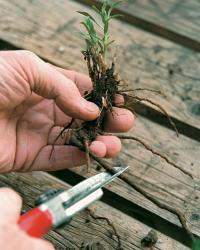

Fast-draining soil and steady watering produces flavor
Tarragon is not particular about temperature and can be grown from Zone 2 to Zone 9. It will benefit from some winter protection in Zone 2, so lay down a 2- or 3-inch layer of straw or dead leaves.
Tarragon’s roots must have fast-draining soil, or they may rot. Keep an eye on plants during the winter or during rainy spells. When in doubt, plant tarragon in a raised bed where good drainage is ensured.
Young plants need to be watered every other day during dry weather. Mature plants should be watered every three days to encourage a continual supply of fresh leaves. Mature plants can survive for long periods without water, but under these conditions they will not grow new leaves.
Although average to good garden soil is adequate for tarragon, we top-dress our beds with compost every winter. This ensures that plants growing for six or seven years do not lose their flavor. If your soil is acidic, tarragon benefits from an application of dolomite for alkalinity and magnesium.
In the Pacific Northwest, tarragon does best in full sun. It will grow well in half-shade in our region, but may not have maximum flavor. In southern California, on the other hand, some shade is beneficial during high summer.
French tarragon is harder to grow in areas of high humidity where the dormant season is short. French tarragon appears to need a two-month dormancy period when the temperature drops close to freezing. Plants kept inside need to be cooled and rested to remain productive. In places without the necessary chill, Mexican tarragon is a good substitute.
Container growing is easy and works well for one season, but the roots soon take up the space of all but the largest container, and the leaves lose flavor. We have had no problems from pests and diseases and theorize that the anise flavor works as a repellent.
Cut back in June for a continuous harvest
Heavy users of tarragon will need three or four plants to provide a continuous supply of leaves from early spring to late fall. Individual stems can be shortened and stripped of their leaves, but for a continuous supply through August and September, you must cut back about half your plants in late June, leaving the remaining half for harvesting while the cut ones regrow. The cut should be made about 6 inches off the ground. With careful watering the plants will be ready to harvest again in six weeks.
We have had little success with drying tarragon, as the flavoring oils are elusive. It is better to preserve the leaves in vinegar or to chop and freeze tarragon in water in ice cube trays. However you handle it, tarragon in the kitchen is a delight, as its delicate flavor complements many foods.
Tarragon-stuffed roasted chicken
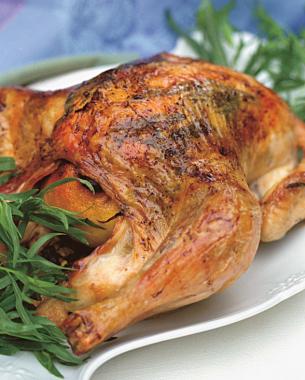
by Noel Richardson
4 servings
1 whole chicken (about 3 lb.)
Salt
2 bay leaves
At least 2 cups tarragon sprigs
2 Tbs. olive oil
Juice of one lemon
Freshly ground pepper
1 cup dry white wine
Preheat the oven to 400°F.
Rinse the chicken in cold water and pat it dry inside and out with a paper towel. Sprinkle the interior with salt and place the chicken in a roasting pan. Put bay leaves and a handful of tarragon sprigs under the bird to flavor the pan drippings. Rub the chicken with the olive oil and squeeze the lemon juice over the chicken. Place the squeezed lemon halves in the cavity along with a good handful of tarragon. With your fingers, slide some sprigs of tarragon under the breast skin. Sprinkle with pepper. Pour the wine into the pan.
Put the chicken in the preheated oven and cook for 1½ hours, basting occasionally. Add extra water, wine, or stock if the liquid in the roasting pan dries up.
Serve the chicken on a platter, garnished with sprigs of fresh tarragon. Skim the fat from the pan juices and serve the juices with the chicken.
500 cal, 31g fat, 135mg sodium, 0g fiber
Tarragon Cream Cheese
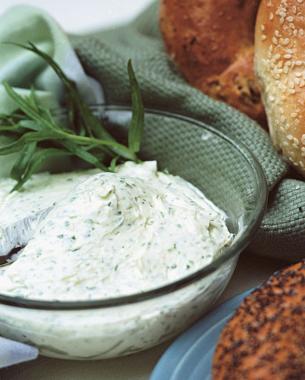
Makes 1 cup
One 8 oz. package cream cheese, at room temperature
¼ cup finely chopped tarragon
Freshly ground pepper
1 garlic clove or shallot
Place all the ingredients in the bowl of a food processor and blend until well mixed. Place in a serving bowl and enjoy.
50 cal, 5g fat, 40mg sodium, 0g fiber, per Tbs.



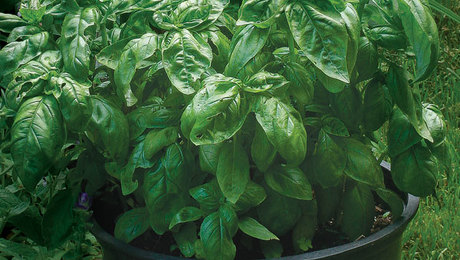
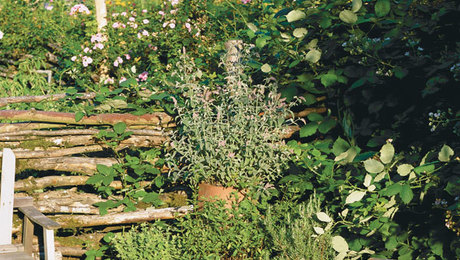
















Comments
My French tarragon in pot is still under the soil. I am in California. I hope it will grow soon. Does anyone know when that usually is?
I'm in Washington and mine's already a foot tall! It's also in a pot, a large, deep one for adequate room for roots. Give it a couple more weeks :)
Thanks, I just looked nothing was out of ground. Last year it got white fly insects that I sprayed but it was in November and stopped growing. I thought maybe it will next year but now I am getting disappointed. I'll wait to see. It was established one and I hope I will not start from scratch! Mine is in a large deep pot too.
My French tarragon grows like a weed! It grows to 5 feet tall and retains that wonderful flavor. I trim it in half in mid June. It grows back to 5 feet by August. I don't grow it in a container, but let it grow as another attractive plant in my yard. I cut it back again in the fall. In the spring I remove as many dead stalks (more like canes) as I can before growth really takes off. We are in zone 3/4.
Users are introduced to so many games that this has
play checkers online free become the best entertaining source for most people.
Log in or create an account to post a comment.
Sign up Log in